paddlesteamers.info : The Internet's leading website for
Side-Wheeled Paddle Steamers
River Seine and Normandie Coast, France
The
Seine is one of France's major rivers, linking the national capital,
Paris, to the sea at Le Havre and flowing through Rouen, the capital of
the province of Normandy. Always a major transport route, its
importance declined with the advent of railways, but Le Havre remains a
major international sea port. Paddle steamers provided a transport
service along the river for a short time and excursions, particularly
out of Rouen, for a little longer. They also found a role in crossing
the Seine estuary and linking Le Havre with the coastal resorts of
Normandy, particularly Trouville.
Rouen and the River Seine
The first steamship to navigate the River Seine to Paris was the Elise
in 1816 and from August the following year instituted a regular daily
service between Elbeuf and Rouen. The service lasted for two years
until technical issues brought it to an end. Elise had been built in
1814 by Archibald McLachlan at Dumbarton, Scotland as Margery to
inaugurate a service on the Thames between London and Gravesend.
The enterprise faltered in the face of opposition from vested interests
(ie the Thames "watermen") so the ship was sent to France, becoming the
first steamship to cross the English Channel, reaching Paris on March
16th, 1816.
Not until 1826 were services resumed
with the paddle steamer Dauphin after which there was rapid growth with
new vessels and expanded services all leading to intense competition
between ship owners on services linking Rouen with Paris upstream and
also downstream to the coast at Le Havre. Traffic was most intense in
the area around Rouen but business upstream to Elbeuf tailed off
considerably after the opening of a railway in 1853, but downstream to
La Bouille, the railway did not arrive until 1883. After this time,
freight traffic continued using screw steamships and passenger vessels,
paddle steamers amongst them, sought a new market in offering local
excursions, particularly on weekends and public holidays. The
local Compagnie des Bateaux Omnibus offered
a Rouen to Le Havre outing
in association with the local railway company for Parisians who then
returned fully by railway and the motor vessel Felix Faure, built in
Nantes in 1896 was the regular vessel on that route. From 1909 the
"Omnibus" company became the Compagnie Rouennaise de Navigation a Vapeur.
The
Rouen company also operated stea,ers on the ferry service between the
Normandy coast at Carteret and the island of Jersey (Gorey)
Some later paddle steamers :
Chamois was built in 1875 for Louis Bertin's Rouen-Honfleur-Le Havre route.
Antilope
was a cargo and occasional passenger steamer built in Nantes in 1896
for service on the Loire. It
sailed on the Seine itself and along the coast and was seen at
Trouville and as far away as Cherbourg
Elan
Boieldieu was
the former Vanbrugh built in 1905 for service in
London but only running there for two years as the city council's
over-ambitious water-bus scheme collapsed in financial disarray. sailed
for the Cie Rouennaise de Navigation until the late 1930s
Jersey ferries :
Cygne was
built in 1854 by A Normand at Le Havre as Halloin but had become Cygne
in 1882. She came to the Jersey service in 1894, being substantially
renovated soon afterwards. She served until October 1912 and was
scrapped in Boulogne the following year.
Jersey
was bought by the Cie Rouennaise de Navigation in 1913 from the Great
Yarmouth Steam Towing Company of the UK where the 1896-built paddle
steamer had been called Lord Nelson. Built by Allsup in Preston she was
133.3 ft long and had a GRT of 229. She had two single-cylinder
diagonal engines of 30 x 48 in. She ended her service in October
1914 following the outbreak of World War I, which she spent on wartime
duties. Although she returned following the war, reentering service in
August 1919, traffic was poor and the company abandoned the
service in early 1920. She was was later sold for use as a tender
to transatlantic liners at Cherbourg and renamed Au Revoir but also
returned to the carteret-Jersey run for the main 1925 and 1926 seasons.
In 1928 she was operated out of the Mediterranean port of Nice as La
Dryade but iunder Monegasque state ownership. She was later converted to a barge in 1934
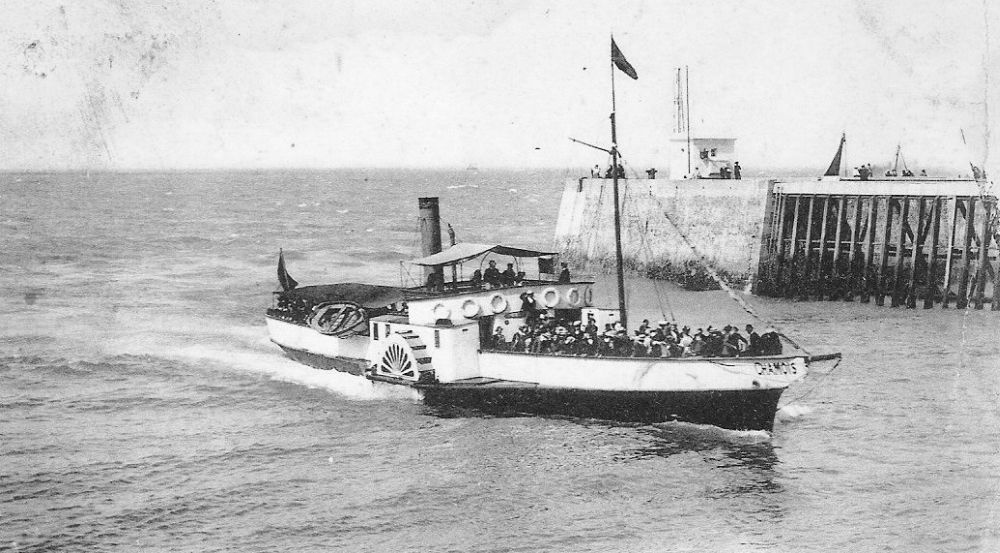
Above : Chamois in a post card view at Le Havre

Above : Post card view of Antilope on a trip out to sea to Trouville
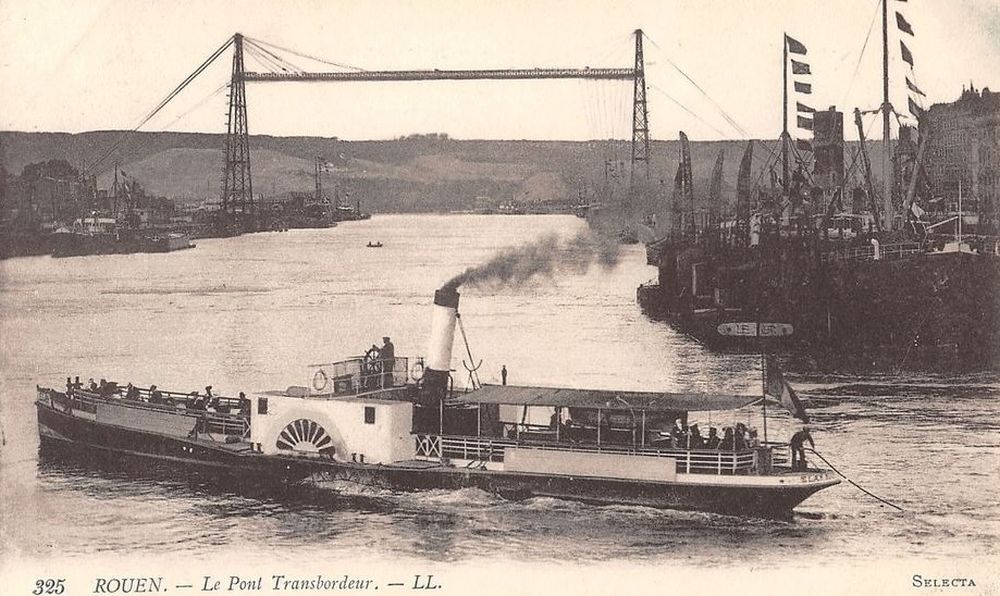
Above
: Leon & Levy post card view of Elan near the Transporter Bridge which was
built in 1898 and destroyed in 1940 to delay the advance of invading
German troops.
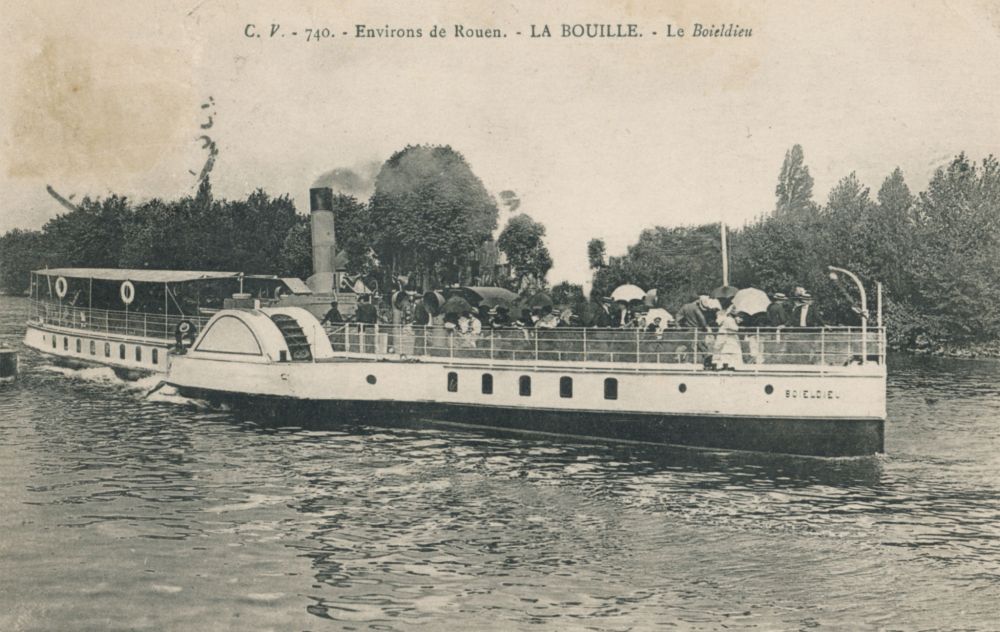
Above : Post card view of Boieldieu at the favoured excursion destination of La Bouille
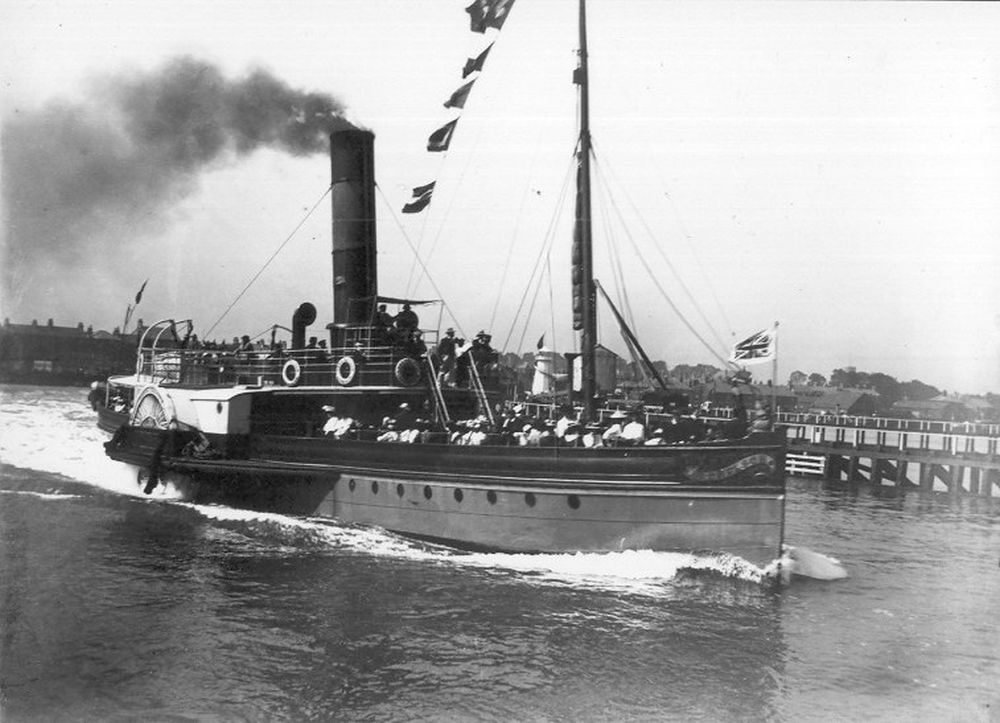
Above : Jersey in her earlier life as Lord Nelson. Photo on the Shipping and Shipbuilding UK database
Le Havre and the Normandie Coast
As
well as services down the Seine to Rouen, paddle steamers took
passengers from the major port town of Le Havre across the Seine
estuary to Honfleur and onward along the Normandie coast to the resort
of Trouville and as far as the city of Caen on the river Orne. Paddle
steamer replacement had already begun on the passenger service by 1882
when the first screw steamer was introduced on to the run
The
first paddle steamer ailing across the estuary was the Triton in 1820.
It was joined by the Rapide and the Gazelle
Services from Le Havre to Caen were established in 1837 with the
formation of the "Societe des Paquebots a vapeur entre le Havre et
Caen" with the ships Calvados, Neustrie and Orne. In 1839 three ships,
Colibri, Ocean and Vesuve established a service to Cherbourg. In 1843
services began between La Havre and Trouville.
The "Compagnie Anonyme des Paquebots a vapeur entre le Havre, Caen, Honfleur et les ports de la Normandie"
was established in 1862 following a number of amalgamations and the
fleet consisted of Cygne, Orne, Manche, Normandie and Calvados. The
company was then re-established in 1897 as "Compagnie Normande de Navigation a Vapeur". Much of their business was in cargo with dedicated screw steamers.
Known later paddle steamers
La Dives - served between Le Havre and Caen
Le Francais (1835-1875, built for the Vieillard company's Le Havre- Honfleur route)
Le Courrier former Calais to Dover steamer purchased by Deschamps from Vieillard & Cie. Wrecked at Ouistreham in 1885)
Orne (1851, built by Chantiers Auguste Normande at Le Havre for service to Caen)
Hallion (Cygne from 1882) (1851-1894,
built by Normande with engines by Mazeline Freres. Operated from
Carteret to Jersey for the Cie Rouennaise de Navigation until 1912)
Eclair (1856-1879, sold to Louis Bertin for his Seine service to Rouen, then later to the Cie des Bateaux Omnibus )
Francois 1er (1866-1911, sailed principally between Le Havre and Honfleur)
Hirondelle (1875-1928, built by Chantier des Nieges in Le Havre for the service to Caen)
Rapide (1881-1938)
Gazelle (1884-1937, built by Chantiers Auguste Normande at Le Havre for the Cie Normande's Trouville service)
La Touques (1901-1940)
In 1878 a new company the Compagnie of Steamers
chartered two paddle steamers to challenge the main incumbent operators
of the Le Havre-Trouville service, Deschamps' Compagnie des Paquebots a
Vapeur. The ships brought in were old cross-channel paddle steamers Diamant and Perle.
Diamant dated from 1846 when she was built for the Belgian Governement
by London shipbuilders Ditchburn & Mare with engines by Maudsley
and originally named Chemins de Fer. Renamed Diamant in 1852, she ran
the packet service between Ostend and Dover. In 1872 she was bought by
French owners, renamed Nord and put on the Calais to Dover service.
Perle
was built by Thames Ironworks in Blackwall, London in 1859 as John Penn
for cross-channel service, becoming part of the Chatham & South
Eastern Railways in 1864.
Oscillating engines were by John Penn & Sons
She
was renamed Perle when bought by the Belgian governement in 1866 to
partner Diamant on the Ostend to Dover run and followed Diamant into
French ownership.
The challenge only lasted two years. Diamant
was then in the posession of Compagnie des Paquebots a
Vapeur until 1882. Perle was converted to a barge and used on the
Seine

Above : Rapide at Trouville in a Leon & Levy post card view
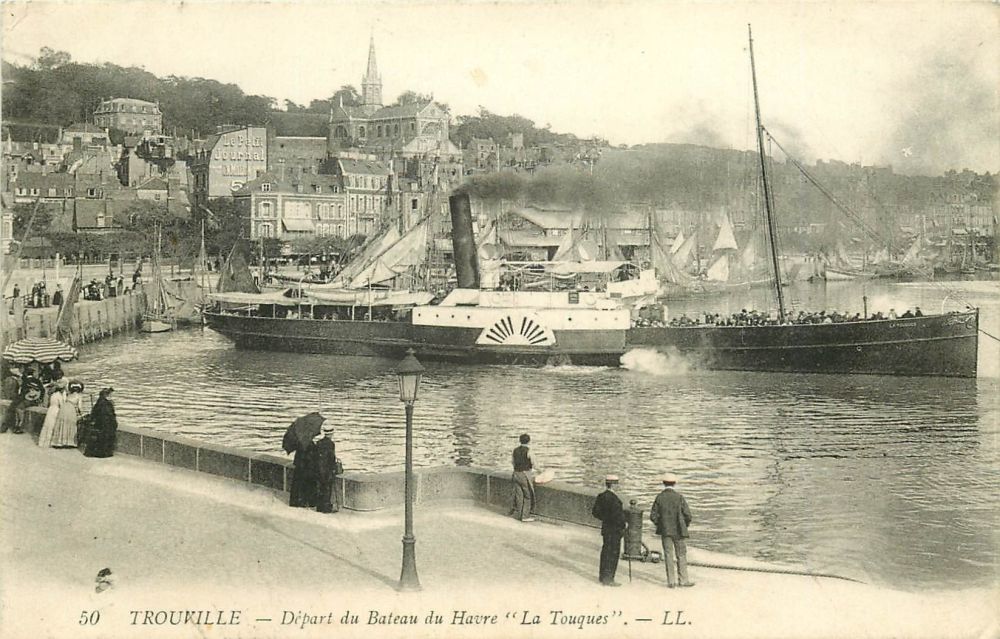
Above
: Leon & Levy post card view of La Touques leaving Trouville. The final design of
"Le Havre" paddle steamers and the last survivor. She had been laid up
since 1937 in the port of Le Havre in view of the ferry run to Honfleur
being deemed uneconomic when she was reactivated in 1940 to assist in
the evacuation of civilians facing the advance of German troops. Her
journey from Ouistreham aiming for St Malo came to an end when she was
wrecked off Dinard. All passengers were saved. The ship was eventually
raised and scrapped in St Malo in 1941.
Le Havre Harbour Paddle Tugs
Jean Bart (1872-1899) Built in London in 1859 as Enterprise
Trouville (1884-1888) Built in London in 1874 as Hibernia. Returned to UK to Middlesbrough as Hibernia. Served until 1917
Surcouf (1891-1900) Built in London in 1874 as Scotia. Returned to UK to Middlesbrough as Scotia. Served until 1917
Return to
Historical Database






